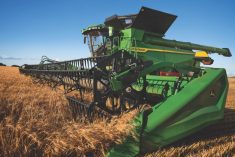Deere has trimmed its annual profit forecast for the second time, squeezed by slumping demand for tractors and combines as falling crop prices pressure farm income.
Farm income is expected to slide 25.5 per cent to US$116.1 billion this year from 2023, according to the U.S. Department of Agriculture, set for a second consecutive annual drop, as corn and soy prices plummet and production costs increase.
Higher interest rates have also piled pressure on farmers, leaving equipment dealers with bloated inventories, prompting some to offer discounts or even auction off machines at lower prices, forcing Deere and peers to cut production.
Read Also

Deere forecasts weak annual profit on tariff hit
Deere & Co forecast an annual profit below estimates on Wednesday, pressured by tariff impacts and weaker margins from its large tractors, sending the farm-equipment maker’s shares down nearly five per cent.
The world’s largest farm equipment maker now expects fiscal 2024 net income of about $7 billion, down sharply from its prior expectations of $7.50 billion to $7.75 billion.
Deere’s shares fell 3.2 per cent in early trading. Peer Caterpillar, which last month warned of weaker second-quarter sales, also slid one per cent.
The forecast implied “a very aggressive” downshift in production in the second-half of the year, Jefferies analyst Stephen Volkmann said.
Deere expects sales of large agriculture equipment to decline between 20 per cent and 25 per cent this year, compared its prior estimates for a roughly 20 per cent fall. Industry sales for large agriculture equipment was projected to fall about 15 per cent, at the low end of its previous forecast.
“There were some signs (that guidance might be impacted), but I was still surprised to see them cut guidance for the industry… It was a bit more broad-reaching than I would have expected,” M Science research analyst Alex Prudhomme said.
“Their guidance always implied that they were going to underproduce retail sales to work down inventory. Now that they’ve cut retail sales (targets) across all markets, they’re going to have to work a lot harder to achieve that goal.”
Net income for the second quarter fell 17 per cent to $2.37 billion, or $8.53 per share. Net sales declined 15 per cent to $13.61 billion. However, both beat Wall Street expectations.













